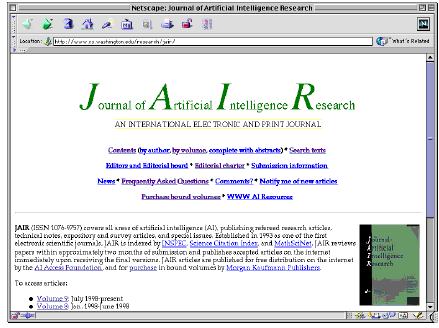Hypermedia Online Publishing: the Transformation of the Scholarly Journal
6.3.2 Journal of Artificial Intelligence Research
Overview
The Journal of Artificial Intelligence Research (JAIR) is a peer-reviewed e-journal that began accepting submissions on June 15, 1993 and published its first article in August, 1993. The publisher is the AI Access Foundation. The journal is available online at <http://www.cs.washington.edu/research/jair/> . From its inception, it has been managed as a grass roots exercise with no formal budget. The labour and resources required to run the journal are donated by individuals and scientific organizations on an as needed basis. A small seeding grant was provided by the The American Association for Artificial Intelligence to pay for JAIR's start-up legal expenses. The opening screen for the JAIR Website is shown in figure 6-2.
|
|
JAIR has been described as the "Stealth E-journal of Artificial Intelligence Research" [Kling and Covi, 1995] because of the way in which it exploits the Web to provide easy and broad distribution while providing authors with publication in a medium which looks like a print journal when reproduced or cited. They also describe its deliberate and intelligent use of some of the social aspects of electronic scholarly publishing:
By publishing polymorphously in paper and electronic media, this journal (JAIR) can offer an electronic edge to authors while appearing traditional to those who do not know its workings. Its authors and readers are part of a scholarly community where there is strong consensus on a computerized typesetting format (in this case Postscript), and in which every research lab has free (or subsidized) electronic access to Internet services. And JAIR is allied with a (commercial) publisher that routinely markets and sells books to libraries, scholars and professionals. One other key feature of JAIR's stealth approach is that it doesn't broadcast its e-journal status in its name. It is a fascinating model. [Kling and Covi, 1995]
JAIR publishes full-length research articles, short technical notes, and survey and expository articles. JAIR's editorial board is dedicated to the rapid dissemination (publication online within two months of submission) of important research results to the global AI community. The journal's scope encompasses all areas of Artificial Intelligence, including automated reasoning, cognitive modelling, knowledge representation, learning, natural language, neural networks, perception, and robotics.
Access
Access to the online version of the journal is free with no indication of any change in status in the future. JAIR deliberately uses the widest possible range of electronic distribution technologies. It is possible to access JAIR articles using news (from the comp.ai.jair.announce and comp.ai.jair.papers newsgroups), on the Web, via anonymous ftp and via automated email. The online version of JAIR is supported by USC/ISI, the University of Washington, Carnegie-Mellon University, the University of Genoa, and NASA's Ames Research Center.
The journal is also sold as a printed annual issue by Morgan Kaufmann Publishers at a cost of US$75.00 per volume (typically two volumes per year). The journal's Website exhorts readers to encourage their library to subscribe to the printed version, as revenues from such sales help support JAIR's operation.
Navigation
The Web site provides a table of contents by volume, another version by author, a complete list of titles with abstracts and a search engine which supports keyphrase and full-test searching. The search engine (hosted by a server in Canada) also links to an Information Space representation of JAIR hosted by a server at MIT. This is typical of the cooperative model that informs much of the work of JAIR.
The ftp server is organised into directories by volume. The automated email server supports single file retrieval and database searching.
Presentation
The default presentation format for JAIR is Postscript. Each article is a single Postscript file, formatted and paginated to match the printed journal. A printout of the Postscript is therefore of somewhat higher quality than a traditional photocopy of an original. Articles are also provided in PDF form from the Website only. Many articles are also available in HTML form. JAIR's editors do not encourage citations to include URLs - they apparently want the printed version of the articles to look as much like 'real' print as possible.
Additional features
Because of the editor's desire to have articles look like print journal articles, much of the possibilities for e-journal innovation are removed. Those articles that provide HTML versions offer the usual features: structuring of the article in chunks, Next/Up/Previous navigation buttons, internal hyperlinks for the article table of contents and footnotes, some external links for things like email addresses and personal homepages. One innovative feature that is available regardless of format is the possibility of online appendices. This possibility is sometimes used by authors to provide demonstrations or source code for algorithms and programs discussed in their articles.
Last modified: Monday, 11-Dec-2017 14:39:30 AEDT
© Andrew Treloar, 2001. * http://andrew.treloar.net/ * andrew.treloar@gmail.com
